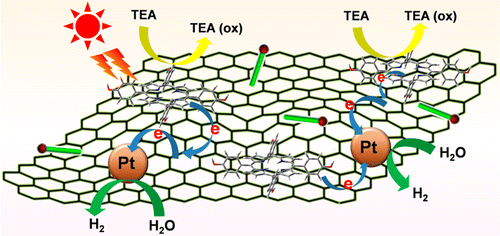Surfactant Assistance in Improvement of Photocatalytic Hydrogen Production with the Porphyrin Noncovalently Functionalized Graphene Nanocomposite
Mingshan Zhu ‡, Zhi Li †, Bin Xiao †, Yongtao Lu †, Yukou Du †, Ping Yang *†(杨平), and Xiaomei Wang †
† College of Chemistry, Chemical Engineering and Materials Science, Soochow University, Suzhou, 215123, China
‡ CAS Key Laboratory of Colloid, Interface and Chemical Thermodynamics, Institute of Chemistry, Chinese Academy of Sciences, Beijing, 100190, China
ACS Appl. Mater. Interfaces 2013, 5, 1732–1740.
In this paper, a 5,10,15,20-tetrakis(4-(hydroxyl)phenyl) porphyrin (TPPH) noncovalently functionalized reduced graphene oxide (RGO) nanohybrid has been facilely synthesized by immobilizing TPPH on RGO nanosheets. This nanohybrid was characterized by atomic force microscopy (AFM), transmission electron microscopy (TEM), and UV–vis spectra, which demonstrated that the TPPH molecule was attached on the surface of the graphene nanosheet. The results of fluorescence quenching and photocurrent enhancement of TPPH–RGO exhibit that the fast electrons transfer from photoexcited TPPH molecules to RGO sheets. Compared with bare TPPH or RGO functional Pt nanoparticles, the TPPH-sensitized RGO loaded with Pt nanoparticles shows remarkable enhanced photocatalytic activity under UV–vis light irradiation. The superior electron-accepting and electron-transporting properties of graphene greatly accelerate the electron transfer from excited TPPH to Pt catalysts, which promote the photocatalytic activity for hydrogen evolution. More importantly, with the assistance of cetyltrimethylammonium bromide (CTAB) surfactant, the catalytic activity and stability is further improved owing to aggregation prevention of TPPH–RGO nanocomposites. Our investigation might not only initiate new opportunities for the development of a facile synthesis yet highly efficient photoinduced hydrogen evolution system (composed of organic dye functionalized graphene) but also pave a new avenue for constructing graphene-based matericals with enhanced catalytic performance and stability under surfactant assistance.

链接: //pubs.acs.org/doi/abs/10.1021/am302912v